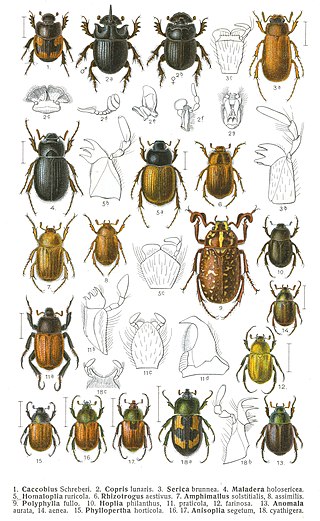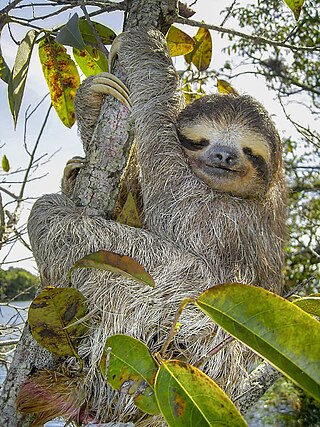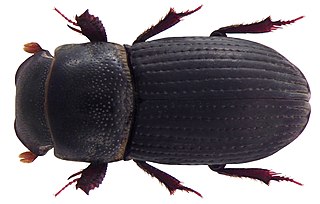
The family Scarabaeidae, as currently defined, consists of over 35,000 species of beetles worldwide; they are often called scarabs or scarab beetles. The classification of this family has undergone significant change. Several groups formerly treated as subfamilies have been elevated to family rank, and some reduced to lower ranks. The subfamilies listed in this article are in accordance with those in Catalog of Life (2023).

Dung beetles are beetles that feed on feces. Some species of dung beetles can bury dung 250 times their own mass in one night.

Aphodiinae is a subfamily of the scarab beetle family, Scarabaeidae. Members of this subfamily are known commonly as the small dung beetles and many, but not all, are dung beetles. These beetles are found worldwide.

Scarabaeus sacer, common name sacred scarab, is the type species of the genus Scarabaeus and the family Scarabaeidae. This dung beetle is native of southern Europe, northern Africa and western Asia, and it was venerated in ancient Egypt.

Bubas is a genus of dung beetles in the family Scarabaeidae, found mainly in the Palearctic and Australia.
Dicranocara is a genus of Scarabaeidae or scarab beetles in the superfamily Scarabaeoidea. Dicranocara is endemic to the Richtersveld National Park. Three species are known, D. deschodti Frolov and Scholtz, D. tatasensis Deschodt and Scholtz and D. inexpectata Deschodt and Scholtz. Only D. tatasensis occurs south of the Orange River.

Eurysternus is a genus of Scarabaeinae or dung beetles in the family Scarabaeidae. It is normally placed in the Oniticellini, although some authors consider it the single genus in the tribe Eurysternini (e.g.). It is restricted to the Neotropics and includes 53 recognized species.

Onthophagus is a genus of dung beetles in the Onthophagini tribe of the wider scarab beetle family, Scarabaeidae. It is the most species-rich and widespread genus in the subfamily Scarabaeinae, with a global distribution.

Heliocopris is a genus of Scarabaeidae or scarab beetles in the superfamily Scarabaeoidea. Forty-seven of the fifty-two known species are found in Africa, but a few are found in southern and southeast Asia.

Digitonthophagus gazella is a species of scarab beetle. It belongs to the genus Digitonthophagus, which was promoted from subgenus to genus level in 1959. There has been some confusion regarding the application of the names with many people using the outdated name Onthophagus gazella. Dung beetle experts use the term Digitonthophagus gazella.

A large number of arthropods are associated with sloths. These include biting and blood-sucking flies such as mosquitoes and sandflies, triatomine bugs, lice, ticks and mites. The sloth’s fur forms a micro-ecozone inhabited by green algae and hundreds of insects. Sloths have a highly specific community of commensal beetles, mites and moths.

Phanaeus, the rainbow scarabs, is a genus of true dung beetles in the family Scarabaeidae, ranging from the United States to northern Argentina, with the highest species richness in Mexico. Depending on species, they can inhabit a wide range of habitats, from tropical to temperate climates and deserts to rainforests. In those living in relatively arid places adults are primarily active during the wet season and those living in relatively cold places are primarily active during the summer. They are excellent diggers and good fliers.
Sudhausia is a genus of nematodes (roundworms) of the family Diplogastridae. They live in association with dung beetles and are primarily known from Africa. Species of Sudhausia show a suite of biological features that, together, are unusual for nematodes and animals in general: hermaphrodites, which are females in form, mature to produce offspring before they are adults and thus even capable of mating, and their eggs grow in size during development. Hermaphrodites are also always live-bearing, which is unusual for nematodes under non-stressful conditions. The genus is named in honor of Walter Sudhaus, a German nematologist.

Teuchestes fossor is a species of dung beetle native to the Palaearctic, but is also widespread in North America following accidental introduction and naturalisation during European settlement. Both adults and larvae are coprophagous, differentiating resource use by respectively feeding on the liquid and fibrous fractions of herbivore dung. It can be readily collected from the dung of livestock, and other large mammals This species is known to support a number of key ecosystem services in cattle pastures.

Cartwrightia is a genus of scarab found in Latin America. It was named and circumscribed in 1958 by Federico Islas Salas. As of 2017, three species are recognized: C. intertribalis, C. cartwrighti, and C. islasi. They can be found in the nests of leafcutter ants or in dung.

Dialytes is a genus of aphodiine dung beetles in the family Scarabaeidae. There are about five described species in Dialytes.

Onthophagus nuchicornis is a species of dung beetle in the family Scarabaeidae. It is found in Europe and North America. Though Onthophagus nuchicornis is listed as "Vulnerable" in the United Kingdom, it is a common and abundant species in North America. It has been used as a model organism for ecotoxicological studies of ivermectin, where different biological endpoints are stimulated at low levels of ivermectin exposure, but impaired at high levels of ivermectin exposure.
Hornietus is a genus of aphodiine dung beetles in the family Scarabaeidae, the sole genus of the tribe Hornietiini. There is one described species in the genus, Hornietus ventralis, found in North America.
Onthophagus unifasciatus, is a species of true dung beetle native to India and Sri Lanka.

Copris repertus, is a species of dung beetle found in India, Sri Lanka and Myanmar.














